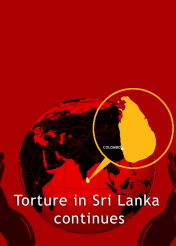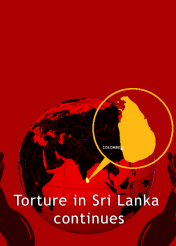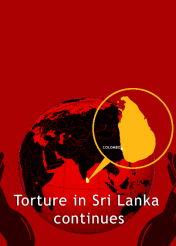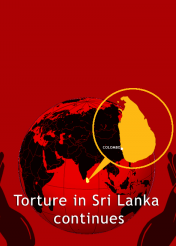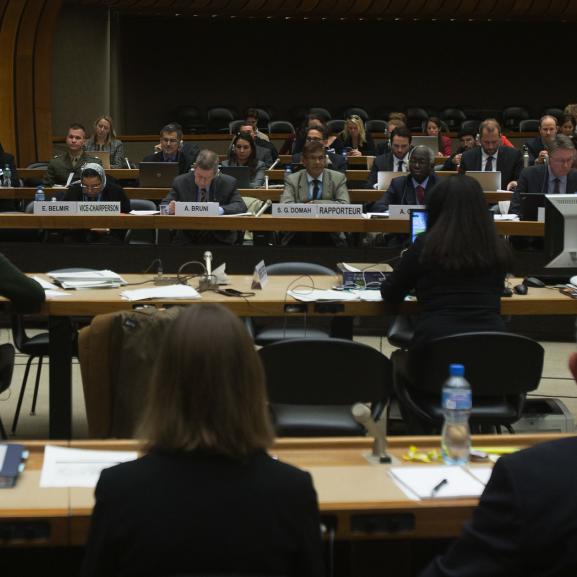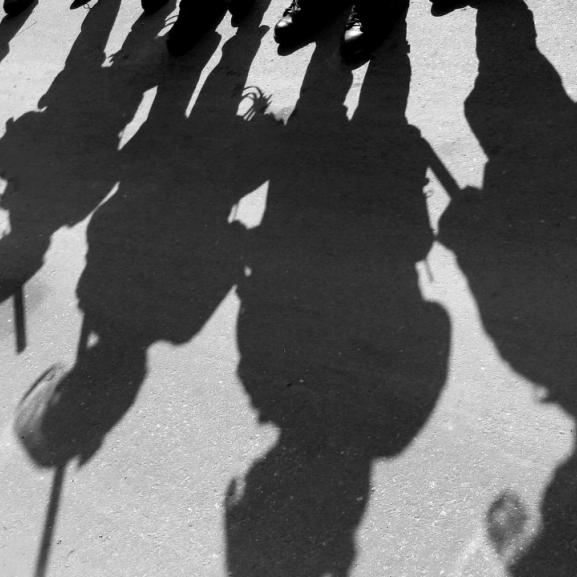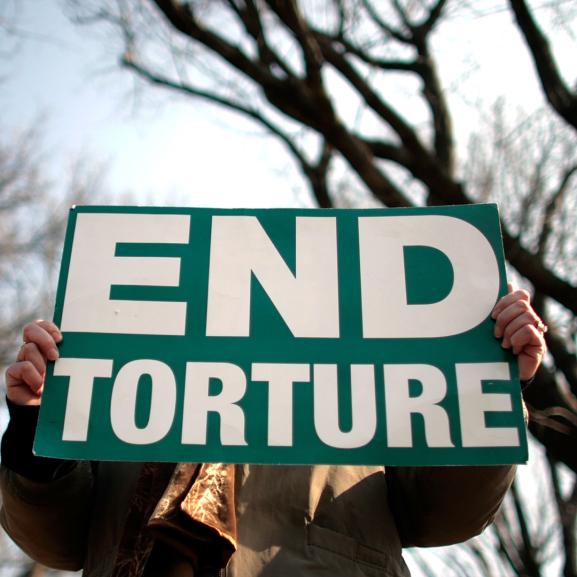Tainted peace: Torture in Sri Lanka since May 2009
Torture has long been used in Sri Lanka to persecute minorities, crush dissent and stifle civil society. It is deeply entrenched in the fabric of the state and has persisted across the decades regardless of changes in political leadership.
Tainted Peace: Torture in Sri Lanka since 2009, a new report by Freedom from Torture shows that one of the most urgent tasks facing the country's new leadership will be to eradicate torture by the military and police, which is deeply entrenched and has tainted the country's peace since May 2009.
Since Freedom from Torture was established in 1985, more than 5,000 Sri Lankans exiled in the UK have been referred to us. In 2014, for the third year in a row, Sri Lanka was the top country of origin for our clients.
Our doctors' forensic reports (medico-legal reports or MLRs) of the physical and psychological consequences of torture document the ongoing suffering of people at the hands of the Sri Lankan military, police and intelligence services. Together these MLRs show that torture did not end when the fighting stopped.
'Tainted Peace' is based on a detailed study of 148 of these MLRs of men and women who were tortured in Sri Lanka between May 2009 and September 2013. Freedom from Torture has continued to receive referrals for Sri Lankans tortured more recently, including in 2014 and 2015.
The Sri Lankan government and the United Nations and wider international community must take urgent action to protect people from torture in Sri Lanka and end impunity for perpetrators.
Watch Our Experts
Who are the survivors?
Of the 148 people whose MLRs we reviewed, 125 were men and 23 were women. Most were aged between 26 and 40, though there were a number of younger men aged between 18 and 35, and some men and women aged between 41 and 60.
The overwhelming majority (139) were of Tamil ethnicity. One-hundredand forty-two people reported that they were tortured because of a real or perceived association with the Liberation Tigers of Tamil Eelam (LTTE). Some were members of or supported the LTTE, whether voluntarily or because they were forced and often at a very low level. For many, however, an LTTE association was wrongly imputed to them, including because of family connections.
One-hundredand forty-two people reported that they were tortured because of a real or perceived association with the Liberation Tigers of Tamil Eelam (LTTE). Some were members of or supported the LTTE, whether voluntarily or because they were forced and often at a very low level.
It is of particular concern to Freedom from Torture that more than one third of the people in this study were tortured after returning to Sri Lanka from the UK after the end of the armed conflict (55 of 148 cases or 37%). Most had been in the UK as students but three had claimed asylum and were forcibly removed after their claims were rejected. Most were specifically interrogated about why they were in the UK and the activities of the Tamil diaspora. Twenty-one people were accused of participating in lawful demonstrations and other protests about Sri Lanka in the UK and eleven were shown photographs taken at these events.
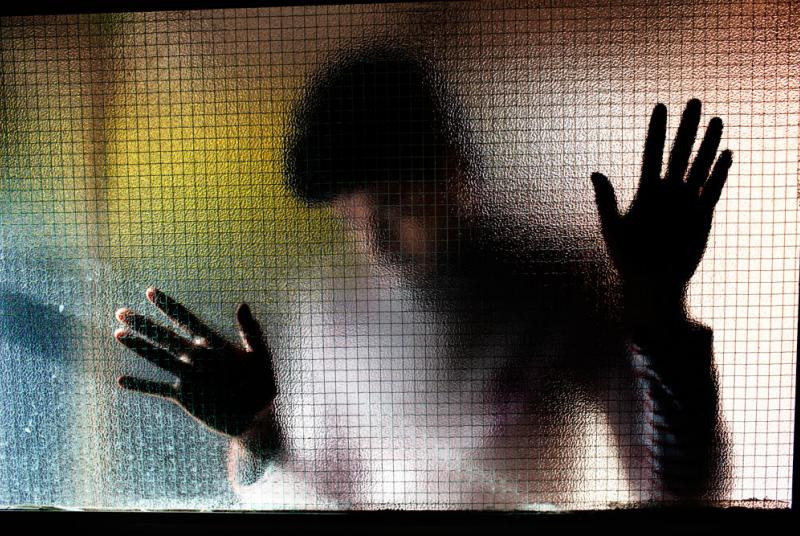
John's Story
John, now 25, spent four months with the Liberation Tigers of Tamil Eelam (LTTE) after being indoctrinated and recruited by an older man while he was studying for his A-levels aged just 18.
He took just a few t-shirts and jeans – he didn't tell his parents.
At the LTTE camp he completed his basic military training and then worked as a cook and cleaner.
John was captured by the Sri Lankan army after his first battle. He was taken to Boossa camp where he was detained and tortured for four months.
John was released when his father paid a bribe but was re-arrested by police several months later and was detained, held in solitary confinement and tortured for another year.
In November 2010 on discovering his son's whereabouts John's father, again, paid an agent to get John out of prison. He then came to the UK with a student visa.
In London he stayed with a cousin and attended English lessons at a college.
"When my mum and dad asked me to consider coming back to Sri Lanka, my heart jumped. I missed my family and they clearly missed me and wanted me home.
"The war had been over for three years and my parents thought it would be safe for me to return. I didn't expect any problems. I had been out of Sri Lanka for two years and only had a very limited involvement with the LTTE.
"I boarded a Sri Lanka Airways flight in London destined for Colombo. When we arrived they were waiting for me at passport control.
I was taken from the airport to Welikada prison. The cell was dark and it smelled terrible. They beat me every single day I was in that place. I was tied by my ankles and hung naked upside down from the ceiling. They hit my body with steel wires and plastic pipes filled with sand
"I was held at the airport for five hours, they asked me again and again 'What were you doing in London against the Sri Lankan government?', 'Who is organising protests in London?'. I realised that I was being held because I attended anti-government protests while I was in London – I don't know how they knew that.
"When then President Rajapaksa visited London in 2012 I took part in a demonstration against him. There were hundreds of us there, I have no idea how they identified me.
"I was taken from the airport to Welikada prison. The cell was dark and it smelled terrible. They beat me every single day I was in that place. I was tied by my ankles and hung naked upside down from the ceiling. They hit my body with steel wires and plastic pipes filled with sand.
"My head was held underwater until I was suffocating and choking. They also put petrol in plastic bags and held them over my head till I passed out.
"It was in Welikada that they also practised some sexual torture on me. This is something that is very difficult to talk about in my culture.
"I was only in that place 13 days until my father and uncle paid bribes to get me out, but it felt like a lifetime. I had to sign some kind of confession before I left prison. It was in Sinhalese so I have no idea what it said – I would have signed anything to get out of that place.
"My father had paid an agent to arrange my papers and get me out of Sri Lanka undetected. I didn't know where I would end up when I got on the plane. My wounds were extremely painful, but I was very relieved to be safe.
"Although the government in Sri Lanka has changed now, I believe there is just going to be the same problem. The army will still carry on this practice – they are organised, they have systems. Changing the leader means nothing. The army is still all over the north and everything is still very militarised. Why would they keep such a heavy army presence there if they thought there was no security threat from Tamils?"
Although the government in Sri Lanka has changed now, I believe there is just going to be the same problem. The army will still carry on this practice – they are organised, they have systems. Changing the leader means nothing. The army is still all over the north and everything is still very militarised.
Using forensic documentation methods as laid out in the Istanbul Protocol, a Freedom from Torture doctor attributed 29 scars on John's body to torture, some were as long as 10 centimetres.
The distribution of some of the scarring suggests, according to the same doctor, that John may have been curled up in the foetal position when some of the beatings were delivered. Scarring on his lower leg is most likely secondary to friction burns from the ropes used to hang him upside down.
Evidence of Torture
The methods of torture included beatings, burning, rape and other forms of sexual violence, asphyxiation, electric shocks, mock executions, and stabbings.
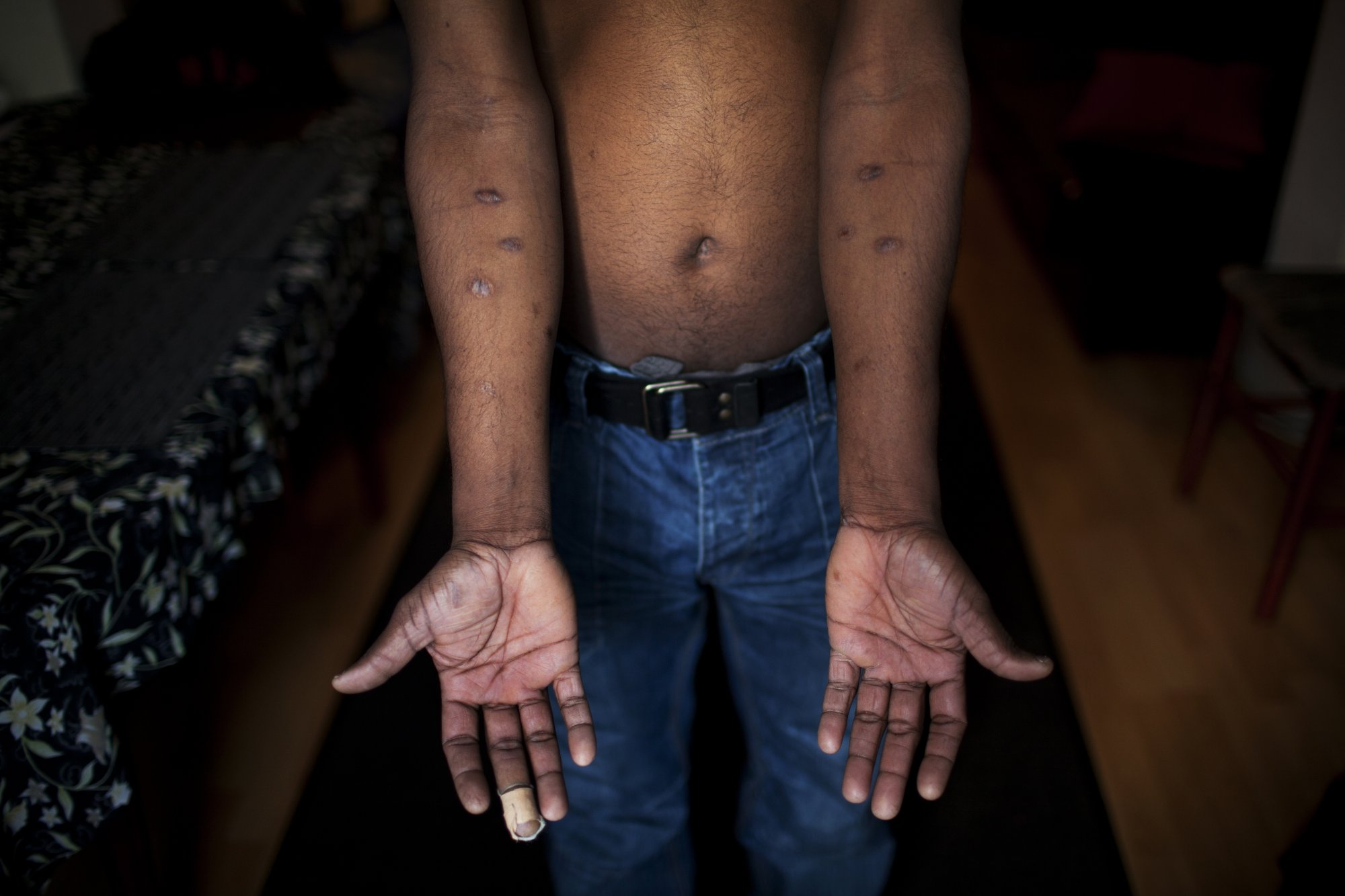
A Tamil, who is a survivor of torture at the hands of Sri Lankan security forces, displays scarring from cigarette burns on his chest and arms (Photo: Will Baxter) Our study reveals dreadful detention conditions, with many detainees held in darkness and deprived of adequate food and water. Seventy per cent of people were held in solitary confinement. Most detention episodes were six months or less but some people were held for many years.
Methods of torture were often meted out simultaneously: every survivor was beaten, including with blunt instruments, pipes filled with cement or pistol butts. Often these blows were delivered while the person was suspended with both their hands and feet tied up. Some were dropped from a height with bindings still in place so they were unable to break their fall.
Every survivor was beaten, including with blunt instruments, pipes filled with cement or pistol butts. Often these blows were delivered while the person was suspended with both their hands and feet tied up. Some were dropped from a height with bindings still in place so they were unable to break their fall.
The high prevalence of burning with cigarettes or heated pieces of metal (78%) could reflect a policy of branding, not only to inflict long term psychological and physical damage, but to ensure that the individual is easily identifiable in future as having been of adverse interest to the authorities.
People were slapped, punched or trampled on their heads, hands, feet, genitals and abdomen. Many reported losing consciousness – and coming around only to be tortured again.
Some of those who were subjected to water boarding or suffocated with the fumes of burning chillies or petrol said it was the worst form of torture they endured.
Seventy-one per cent of the cases in our study suffered some form of sexual violence as part of torture. Eighty-seven per cent of women and 30% of men were raped. Some women were raped night after night by different officers, while men also described being raped on multiple occasions. Almost half of the people in the study were forced to remain naked, causing them intense humiliation.
Trauma and Recovery
As well as physical scars, many survivors were left to cope with deep psychological repercussions, a common consequence of torture. Such is the intention to destroy an individual's personality and destroy their sense of belonging in family and society. One man described himself as "a dead body".
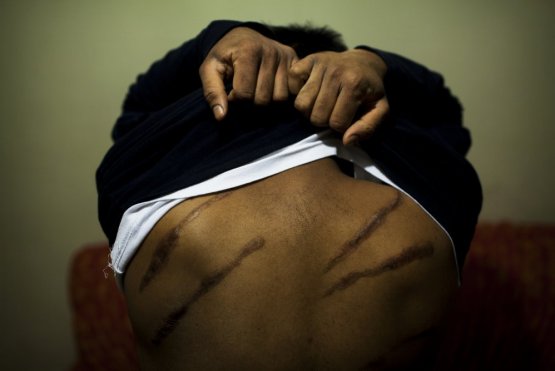
Eighty-nine per cent of survivors in this study showed symptoms of post-traumatic stress disorder (PTSD) and 82% had symptoms of depression. Fifty-five people (37%) expressed ideas of self harm or suicide to their examining clinician and 19 reported having attempted suicide since escaping from detention (13%). Flashbacks and recurrent nightmares were common. Many described other sleeping difficulties, a generalised state of anxiety and social withdrawal.
Arrest and Detention
In all cases the torturers were state actors – the Sri Lankan military and/or branches of the police and intelligence services such as the Criminal Investigation Department (CID) or the Terrorism Investigation Department (TID).
- One-hundred-and-twenty-two people were detained once since 2009, 20 were detained twice, five were detained three times and one individual was detained four times during the post-conflict period.
- Many were abducted by armed men from the street or their homes and taken in 'white vans' to unknown locations.
- Torture in the 148 cases took place in fifteen districts and seven of the nine provinces of Sri Lanka.
- Many detainees were moved around between army camps, prisons, police stations, CID facilities (including its '4th floor' headquarters) and elsewhere. The use of unofficial detention facilities was reported in all years from 2009-13.
- Fifty-five people were detained and tortured after they returned to Sri Lanka from the UK after the civil war ended. Forty-eight of these people were arrested within three weeks of arriving in the Sri Lanka. Eighteen were arrested immediately on arrival at the airport, 19 were taken from their home address, and seven were abducted from the street.
Justice Denied
Perpetrators are allowed to commit torture without fear of consequences.
One-hundred-and-thirty-six people were detained with no formal charge or sentencing, no access to legal representation, no hearing before a judge, no official notification to family members and no access to an independent medical examination.
One-hundred-and-thirty-six people were detained with no formal charge or sentencing, no access to legal representation, no hearing before a judge, no official notification to family members and no access to an independent medical examination.
More than a third were forced after torture to sign blank sheets of paper or 'confessions', usually written in a language (Sinhalese) they did not understand. Others were forced to inform on others.
One hundred and five of the 148 people said they were only able to secure release from detention after bribes paid by family members.
More than a third were forced after torture to sign blank sheets of paper or 'confessions', usually written in a language (Sinhalese) they did not understand. Others were forced to inform on others.
Recommendations
Torture has been part of the modus operandi of the military, police and intelligence services in Sri Lanka for decades and changing this requires a radical transformation which has not been possible in the country yet.
Among Freedom from Torture's most important recommendations are those addressing the need for:
- Member States of the United Nations Human Rights Council and Security Council to ensure without delay a genuine accountability process that meets the highest international standards and all of the following requirements:
- The process must cover serious human rights abuses and associated international crimes committed by both sides to the armed conflict and by the Sri Lankan government in the years of 'peace' since the fighting ended;
- The process must be independent, credible, accessible to victims including those outside the country, transparent and otherwise fully human rights-compliant;
- Any findings on torture from the Office of the High Commissioner for Human Rights' investigation on Sri Lanka should be accepted and accountability delivered; and
- In order to satisfy the international community and win the confidence of victims, including those from the Tamil minority, the process must include strong international participation at every stage and level.
- Sri Lanka to make its 'zero tolerance' policy to torture a reality by suspending from duty those accused of torture, ending use of 'agents' to arbitrarily detain and torture people, and launching criminal investigations and prosecuting those responsible no matter how powerful or senior they are within government or the military, policy and security services.
- Sri Lanka to become an active stakeholder in the Preventing Sexual Violence Initiative including by using the International Protocol on the Documentation and Investigation of Sexual Violence in Conflict in efforts to tackle impunity for sexual torture, and involving survivors of sexual torture in an expert capacity.
- Sri Lanka to ratify the Optional Protocol to the Convention Against Torture and establish an effective torture prevention programme including extensive training within the military, police and intelligence services and measures to enable independent national and international monitors to make regular unannounced inspections of any place of detention including unofficial detention facilities.
- The UK to ensure that individuals are not forcibly returned from the UK to a risk of torture in Sri Lanka including by updating its asylum policy for Sri Lanka to reflect further evidence contained in this report about (i) torture in peacetime Sri Lanka; and (ii) the particular risk for those returning from the UK with a real or perceived past connection to the LTTE, at whatever level and whether directly and/or through a family member or acquaintance.



